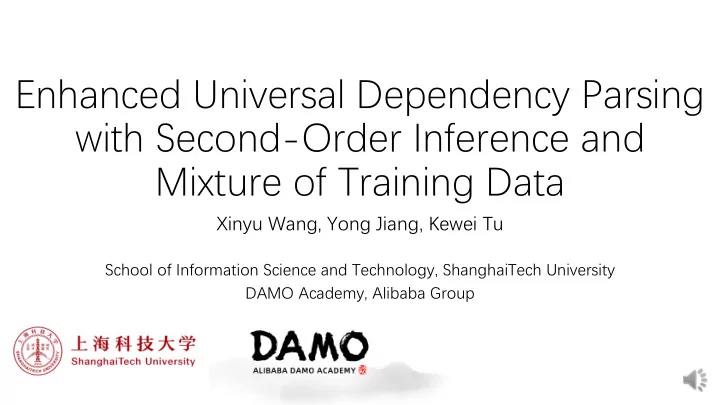

Enhanced Universal Dependency Parsing with Second-Order Inference and Mixture of Training Data Xinyu Wang, Yong Jiang, Kewei Tu School of Information Science and Technology, ShanghaiTech University DAMO Academy, Alibaba Group
Our Parser • A second-order semantic dependency parser based on Wang et al. (2019) • Equip the parser with state-of-the-art contextual multilingual embeddings: XLM-R (Conneau et al., 2019) • Improve the accuracy for the low-resource language (Tamil) through mixing the training set with another language (English/Czech) • Our Parser performs 0.6 ELAS better than the best parser in official results after fixing the graph connectivity issues [1]: Xinyu Wang, Jingxian Huang, and Kewei Tu. 2019. Second-order semantic dependency parsing with end-to-end neural networks. [2]: Alexis Conneau, Kartikay Khandelwal, Naman Goyal, Vishrav Chaudhary, Guillaume Wenzek , Francisco Guzmán, Edouard Grave, Myle Ott, Luke Zettlemoyer, and Veselin Stoyanov. 2019. Unsupervised cross-lingual representation learning at scale.
Preprocessing: Empty Nodes
Preprocessing: Repeated Edges
Preprocessing • Tokenization: Stanza (Qi et al., 2020) • Multiple Treebanks: concatenate the datasets • Splitting the development sets into halves as validation and test sets [1]: Peng Qi, Yuhao Zhang, Yuhui Zhang, Jason Bolton, and Christopher D Manning. 2020. Stanza: A python natural language processing toolkit for many human languages.
Approach (Wang et al., 2019)
Mixture of Training Data For Tamil • Problem: low-resource • Only 400 training sentences for Tamil • Solution: utilizing rich-resource language corpus • Multilingual Embedding: XLM-R • Rich-Resource languages: English (12k sents) or Czech (100k sents) • Remove the label of dependency edges in rich-resource training data • New training data: Upsampled Tamil training data + rich-resource training data • Additional language-specific embeddings: Flair (Akbik et al., 2018) and fastText (Bojanowski et al., 2017) [1]: Alan Akbik, Duncan Blythe, and Roland Vollgraf.2018. Contextual string embeddings for sequence labeling. [2]: Piotr Bojanowski, Edouard Grave, Armand Joulin, and Tomas Mikolov. 2017. Enriching word vectors with subword information
Graph Connection • Original submission: • Non-connected graphs (all potential edges with probability > 0.5) • New solution: • Tree algorithms: Maximum Spanning Tree (MST) or Eisner’s Algorithm • First use MST or Eisner’s algorithm to keep connectivity of graphs and then add potential edges with probabilities larger than 0.5
Results
Results
Mixture of Data Comparison
First-Order vs. Second-Order and Concatenating Other Embeddings *: We use labeled F1 score here, which is the metric for SDP
Comparisons of Graph Connection Approaches (Treebank Level)
Comparisons of Graph Connection Approaches (Language Level)
Thank you • Paper: https://arxiv.org/abs/2006.01414
Recommend
More recommend